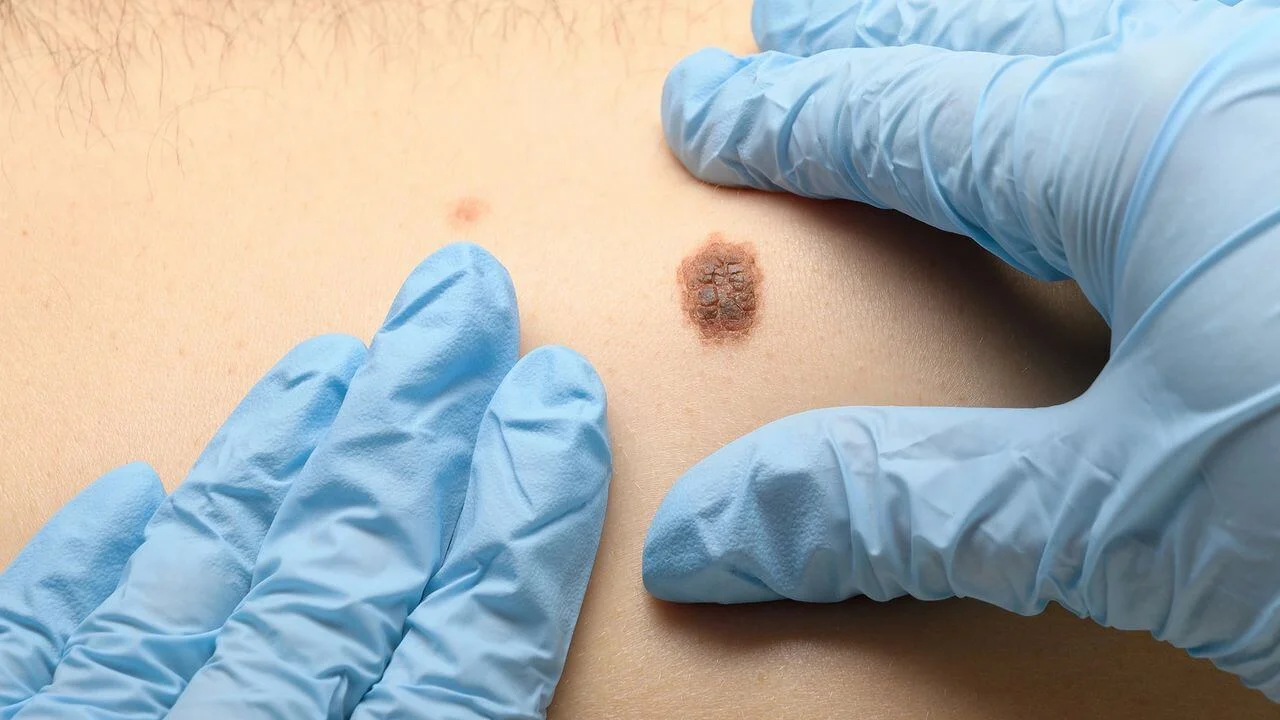Basal Cell Carcinoma: Causes, Symptoms, and Treatment
Learn what basal cell carcinoma (basal cell skin cancer) is, how it relates to keratinocyte carcinoma, and steps for diagnosis and treatment in clear terms.

Basal cell carcinoma (BCC) is the most common form of skin cancer, developing from basal keratinocytes located in the epidermis. BCC rarely spreads but can cause significant tissue damage if untreated. It accounts for about 75% of all non-melanoma skin cancers and primarily affects areas exposed to the sun, such as the face, neck, and arms.
How Does Basal Cell Carcinoma Differ From Other Keratinocyte Cancers?
| Feature | Basal Cell Carcinoma (BCC) | Squamous Cell Carcinoma (SCC) |
|---|---|---|
| Cell Origin | Basal keratinocytes (epidermis base) | Squamous keratinocytes (epidermis surface) |
| Growth Pattern | Slow, local | Faster, can be aggressive |
| Metastasis Risk | Rare (<1%) | Higher (~3%) |
| Appearance | Pearly nodule, ulcer, shiny bump | Scaly, crusted, or wart-like lesion |
| Prevalence of Subtypes | Nodular, superficial, morphoeic | No defined subtypes |
| Typical Patient | Middle-aged/older, sun-exposed skin | Sun-exposed, can develop from AK |
Keratinocyte cancers include both BCC and SCC; actinic keratosis is a common precancerous condition that can progress to SCC.
What Are the Main Causes of Basal Cell Carcinoma?
The primary cause of basal cell skin cancer is chronic ultraviolet (UV) radiation exposure from sunlight or tanning beds. Other risk factors include:
- Fair skin, light eyes, or red/blond hair
- Age over 50
- Personal or family history of skin cancer
- Immune suppression (e.g., organ transplant recipients)
- Exposure to radiation or arsenic
UV rays damage DNA in skin cells, leading to abnormal growth of basal cells.
What Are the Symptoms of Basal Cell Carcinoma?
Typical symptoms include:
- Pearly or waxy bumps, often pink or flesh-colored
- Open sores that don’t heal or bleed easily
- Reddish, irritated patches or shiny scar-like areas
- Rolled, raised borders on skin lesions
BCCs may appear anywhere but are most common on sun-exposed regions. Subtypes, such as nodular, superficial, or morphoeic BCC, can slightly alter presentation.
How Is Basal Cell Carcinoma Diagnosed?
Diagnosis involves:
- Visual skin exam by a doctor or dermatologist
- Skin biopsy to confirm cell type and BCC subtype
A biopsy is essential to rule out other types of skin cancer and decide the best treatment approach.
What Are the Treatment Options for Basal Cell Carcinoma?
Treatment is highly effective, with most BCCs curable if found early:
- Surgical excision: Removal of tumor with clear margins (including Mohs micrographic surgery for high-risk or facial sites)
- Electrodesiccation and curettage: Scraping and cauterizing the tumor
- Topical therapies: Creams or gels for superficial BCCs (e.g., imiquimod)
- Radiation therapy: For patients unsuitable for surgery
- Targeted therapy/Immunotherapy: For advanced or recurrent BCC
What Are Keratinocyte Cancers and Why Are They Important?
Keratinocyte cancer is a term for BCC and SCC, the most common skin cancers worldwide. They outnumber melanoma cases and, left untreated, can cause significant health problems, even death (notably from SCC).
Are There Ways to Prevent Basal Cell and Other Keratinocyte Skin Cancers?
- Use broad-spectrum sunscreen (SPF 30+)
- Wear protective clothing and hats outside
- Limit sun exposure, especially midday
- Avoid tanning beds
- Perform regular skin self-exams
- Schedule annual skin checks if high risk
What Should I Do If I Notice a Suspicious Skin Spot?
- Monitor: Note changes in size, shape, or color.
- Photograph: Take clear photos to track progression.
- Schedule Dermatologist Visit: Early medical evaluation is key.
- Follow Recommendations: If a biopsy is advised, get it done promptly.
- Adhere to Treatment Plan: Follow through with prescribed therapy.
FAQs
Is basal cell carcinoma life-threatening?
How common are keratinocyte cancers compared to melanoma?
Can basal cell skin cancer return after removal?
Does keratinocyte cancer include melanoma?
The information on this page is peer reviewed by a qualified editorial review board member. Learn more about us and our editorial process.
Last reviewed on .
Article history
- Latest version
- Last updated by Dayyal Dungrela, MLT, BSc, BS
Reference(s)
- Telfer, N.R.., et al. “Guidelines for the management of basal cell carcinoma.” British Journal of Dermatology, vol. 159, no. 1, 2008, pp. 35-48., doi: 10.1111/j.1365-2133.2008.08666.x. <https://onlinelibrary.wiley.com/doi/10.1111/j.1365-2133.2008.08666.x>.
- Kim, J.Y.S., et al. “Guidelines of care for the management of basal cell carcinoma.” Journal of the American Academy of Dermatology, vol. 78, no. 3, 2018, pp. 540-559., doi: 10.1016/j.jaad.2017.10.006. <https://pubmed.ncbi.nlm.nih.gov/29331385>.
- Loranger, Nicole., et al. “Combined topical 5-fluorouracil and calcipotriene effectively treats superficial keratinocyte carcinomas: A retrospective cohort study from 2 academic centers.” Journal of the American Academy of Dermatology, vol. 92, no. 3, 2025, pp. 610-612., doi: 10.1016/j.jaad.2024.10.074. <https://pubmed.ncbi.nlm.nih.gov/39532231>.
Cite this page:
- Posted by Nida Hayat Khan